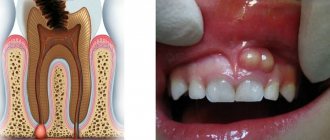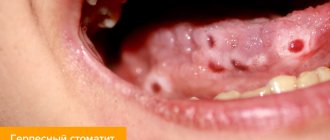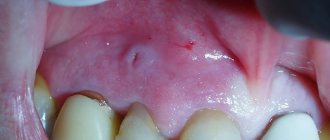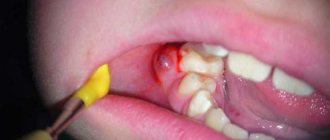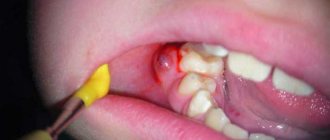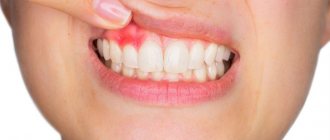A periodontal abscess is an acute purulent inflammation of the gums. A complex pathology in which a purulent sac forms inside the periodontium, which in size can reach the size of a walnut. When a bladder filled with purulent contents ruptures, blood poisoning can occur and the infection can spread throughout the body. That is why it is important to promptly seek help from a specialist who will diagnose the disease, prescribe adequate treatment and prevent relapses.
The main causes of gum abscess
The main reason is the presence of an infection that affects the soft tissue of the gums and the periodontal pocket (the area between the root of the tooth and the gum itself). If no action is taken, the infection spreads throughout the body, affecting organs and systems.
The following pathologies of teeth and gums can provoke the development of infection:
- gingivitis;
- periodontal disease;
- periodontitis;
- deep caries.
Also reasons may be:
- incorrect installation of prosthetic systems or implants;
- mechanical injuries;
- chemical or thermal burns;
- unprofessional installation of braces;
- imperfect filling.
With an abscess on the gum, the inflammatory process develops in the periodontal pocket against the background of the active proliferation of pathogenic microorganisms. At the site of inflammation, dead tissue accumulates in the form of pus, forming a serious abscess, which is accompanied by acute symptoms.
Prevention
- Thorough dental hygiene: brushing your teeth in the morning and evening, rinsing your mouth after every meal, using various devices: dental floss, brushes. If there are dentures in the mouth, it is recommended to clean them of food debris using an irrigator - a special device that supplies water under pressure.
- Timely treatment of diseases of teeth and gums.
- Preventative dental examinations are necessary at least 2 times a year to assess the condition of the teeth and oral cavity. If there is hard dental plaque, use hardware teeth cleaning.
Symptoms of gum abscess
- a painful tubercle on the gum, which upon palpation causes pain and discomfort;
- increased pain during chewing;
- loosening of one or a number of teeth;
- discharge of pus;
- unpleasant taste in the mouth;
- smell from the mouth;
- weakness;
- elevated temperature;
- swelling of the cheek;
- sleep disturbance;
- lack of appetite;
- headaches and dizziness.
In the acute period, all signs of intoxication of the body are observed. When a purulent sac spontaneously ruptures near the gingival margin, a fistula is formed, through which purulent exudate is evacuated. Pus flows into the oral cavity, the pain becomes less. The wound can heal without medication, but in this case there is a high risk of infection of the tissues surrounding the lesion.
Symptoms
A developing tooth abscess causes the following symptoms:
- throbbing pain in the area of the affected tooth, aggravated by chewing;
- inability to fully open the mouth (if the process occurs in the lower jaw);
- exposure of tooth roots;
- pathological mobility of teeth (typical of periodontal abscess);
- painful swelling of the gums and cheeks;
- enlargement of the submandibular lymph nodes;
- increased body temperature;
- headache;
- weakness.
A change in general condition is usually associated with an acute course of the abscess. At the same time, the process can be chronic. For example, with a periapical abscess, a fistula can form - a canal lined with granulation tissue. As a rule, the fistula opens on the mucous membrane of the gums - in the projection of the apex of the tooth root. Less commonly, the fistula opens into the nasal cavity or maxillary sinuses. The fistula serves to remove purulent discharge, therefore, with chronic abscesses, the clinical picture of the disease can be blurred.
Pediatric dentists are faced with abscesses of primary teeth. Its symptoms are the formation of a lump on the gum filled with pus, aching pain in the tooth.
The appearance of symptoms of a purulent abscess requires an emergency visit to a dental surgeon. Otherwise, the risk of complications increases - for example, phlegmon. This is the name of the purulent process in the subcutaneous fat. Unlike an abscess, it is diffuse, i.e. has no clear boundaries. Cellulitis leads to necrotic damage to the jaw bones, and then to infection of the entire body. This process is life-threatening.
Main forms of periodontal abscesses
- Acute – characterized by pronounced clinical manifestations and a sharp increase in pain. Deep periodontal pockets are diagnosed in the oral cavity, individual teeth become mobile, and the person feels a general malaise.
- Chronic – the disease occurs with “erased” symptoms. The gums begin to bleed, the ulcers become more voluminous and dense, and the roots of the teeth become exposed.
Note! Sometimes a periodontal abscess may go away on its own, but this does not mean that the patient has cured on their own. The process can become chronic, poisoning the body with decay products of soft tissues.
Depending on the location of the purulent sac, the following types of abscesses are distinguished:
- basal;
- apical;
- cervical.
Kinds
Dental inflammatory disease, accompanied by swelling and accumulation of purulent exudate, is divided into two categories according to its nature and course.
- Spicy. The disease has a pronounced clinical character. Pathological mobility of elements of the dental system and the formation of deep periodontal pockets are diagnosed. The patient experiences severe pain, malaise, fever, and deterioration in general health.
- Chronic. Painful condition of the gums, bleeding, filling of pockets with a purulent component with a certain frequency. When diagnosing, exposure of the roots of the molars and swelling of the gums may be detected. The patient experiences increased sensitivity to external stimuli.
When opening a periodontal abscess, the localization can be established both in the cervical area and in the apical part of the molar or canine. At this clinic, deep pathological pockets and hard subgingival deposits are recorded. In case of a chronic disease, exacerbation is observed in the autumn-spring period with a sharp change in temperature and immunodeficiency.
Diagnosis and treatment of periodontal abscess
To diagnose the disease, it is enough for the dentist to perform a visual examination with palpation of the inflamed area. Based on the data obtained, the doctor makes a decision on further therapy.
It is important! Periodontal abscess does not need to be heated! Exposure to temperature will only worsen the process and the patient’s condition. The main right decision in this case is to seek qualified help from a dentist.
Basically, the following actions apply:
- surgical opening of periodontal gum abscess with preliminary local anesthesia;
- abscess drainage;
- taking painkillers;
- antibiotic therapy;
- regular rinsing of the mouth with antiseptic compounds;
- vitamin therapy;
- physiotherapeutic procedures.
Causes
The main reasons for the development of a tooth abscess:
- exacerbation of chronic periodontitis;
- accumulation of bacterial infection in the tooth pulp;
- violation of sterility conditions during root canal treatment;
- root cyst;
- vertical fracture of the tooth root.
The bacterial microflora of the oral cavity is represented not only by beneficial bacteria. It is also inhabited by streptococci, staphylococci, cocci, lactobacilli, bacteroides, and spirochetes. The inflammatory process begins with the penetration of pathogenic microorganisms beyond the root apex. Hypothermia, colds and infectious diseases predispose them to increased reproduction.
Causes of dental inflammation
Bacterial damage to dental tissues can occur due to poor oral hygiene and insufficient patient attention to dental health issues. Among the common reasons:
- gum pathologies (periodontitis, periodontal disease, gingivitis);
- spread of caries;
- dental cysts, granulomas;
- cracks, chips on the tooth surface;
- oral injuries (for example, while eating);
- untimely change of toothbrush;
- poor quality teeth cleaning;
- weakening of the immune system.
However, the source of infection can be located in other parts of the body, and bacteria are carried into the gums by the bloodstream. Therefore, close attention should be paid to the treatment of any infectious diseases (especially ENT diseases) and increasing immunity.
Treatment
If you have a periodontal abscess, only a doctor can prescribe treatment. Do not self-medicate under any circumstances, do not try to open an abscess! Such behavior can lead to a sharp deterioration of the condition.
Dental treatment of periodontal abscess comes down to surgical opening of the inflammation and drainage, that is, removal of pus. The cavity is thoroughly cleaned of dead tissue by rinsing with an antiseptic solution. Along with these procedures, the doctor prescribes antiviral therapy to eliminate the source of inflammation.
To speed up the healing of the wounded surface of the gums, laser or physiotherapeutic procedures, as well as iontophoresis, may be needed. After a short period of time after the autopsy, the dentist should examine the patient, make sure that the inflammatory process has stopped and give recommendations for further care of the damaged area.
Acute periapical abscess
It is easiest to deal with visible sources of infection, but acute periapical abscess is very dangerous, since it is almost impossible to notice at an early stage of formation. In this case, the infection begins, literally, from the inside. The infection remaining in the tooth under a filling or in canals with dead pulp after insufficient treatment begins to spread through the roots of the tooth and alveolar bone to adjacent soft tissues. In this case, it is possible to identify the problem before the formation of an abscess or acute pain only with the help of photo X-rays or magnetic resonance imaging (MRI).
How to relieve pain yourself
Before visiting a specialist, you can independently carry out a number of procedures to reduce pain:
- constantly rinse your mouth with an antiseptic solution, for example furatsilin, miramistin or chlorhexidine, and the temperature of the liquid must be at room temperature (on average 20-25 degrees, but no more);
- It is also possible to rinse with well-filtered decoctions of medicinal herbs such as chamomile, sage and St. John's wort;
- In no case should you heat the inflamed area or apply warming bandages and compresses, as this can provoke an increase in the inflammatory process and lead to complications;
- on the contrary, applying ice to the inflamed area helps reduce pain;
- It is recommended to try to carefully clean the diseased tooth and the surrounding space from food debris;
- You should not take strong painkillers without a doctor’s prescription; limit yourself to analgesics sold in pharmacies without a prescription;
- taking antibiotics and anti-inflammatory drugs is contraindicated, because you can not only harm yourself, but also partially eliminate important symptoms by which the doctor determines the nature of the disease.
METROGYL DENTA® for periodontal abscess
METROGYL DENTA® has antibacterial activity and helps relieve inflammation caused by pathogenic microorganisms. The gel can be used to treat periodontal abscess in the postoperative period. Before using the drug, you must brush your teeth. Then a small amount of gel is carefully applied to the affected area of the gum using a cotton swab. The duration of action of the drug is 30 minutes; during this period you should refrain from drinking and eating. The duration of treatment is on average 7-10 days. Before using METROGYL DENTA®, we recommend consulting with your dentist.
Up to contents
The information in this article is for reference only and does not replace professional advice from a doctor. To make a diagnosis and prescribe treatment, consult a qualified specialist.
Diagnostics
The examination includes:
- patient interview,
- inspection,
- dental radiography,
- laboratory and instrumental methods.
During the examination, the doctor sees a painful local bulge and altered mucous membrane. There is no transitional fold from the periodontium to the tooth. The depth of the pockets is at least 3 millimeters.
X-ray shows:
- enlargement of the periodontal gap,
- destruction of the cortical plate,
- uneven resorption of spongy substance.
A blood test indicates nonspecific inflammation:
- high level of leukocytes,
- increase in ESR,
- shift of the leukocyte formula to the left.
PCR allows you to accurately determine the composition of the microflora of the gum pockets. With an abscess, the number of bacteria increases 100 times. During the examination, doctors exclude:
- acute periodontitis or exacerbation of the chronic form,
- cyst with suppuration,
- periostitis,
- osteomyelitis.
What complications can there be?
Even if the pain has dulled, the symptoms have become less pronounced, you should not postpone your visit to the dentist. This situation may be a signal indicating the death of the root and the further spread of infection to the organs of the head or neck.
The area cannot be heated. This approach will bring short-term relief, but will accelerate the formation of the fistula and stimulate the release of pus.
Possible serious complications: brain inflammation, pneumonia. There is a risk of sepsis, development of osteomyelitis, damage to the nasal sinuses or meninges.
Which clinic in Moscow performs the opening of a periodontal abscess?
The DemoStom clinic provides all necessary consultations and diagnostic measures in these cases. The treatment plan is coordinated with a number of specialists. Our dentistry is equipped with innovative equipment; materials and instruments meet the requirements of sterility, and therefore safety. Painless surgery at the DemoStom clinic. Without treatment, the situation can only worsen, leading to serious impairment and even death. Timely contact with dentists helps restore the health and beauty of your smile.
Flux and abscess: causes, diagnosis, treatment methods
Flux and abscess: causes, diagnosis, treatment methods
In modern medicine, the term “flux” as such no longer exists. The once popular word has now been replaced by “odontogenic periostitis.” However, for many, the words “tooth flux” is a more understandable term and means severe pain, swelling and something serious that urgently needs to be addressed to a doctor, and rightly so.
There are different degrees of purulent inflammatory diseases of the maxillofacial area - periostitis (flux), abscess, phlegmon.
Most often they appear against the background of advanced caries.
The first stage of inflammation is periostitis (flux) of the jaw - this is an acute inflammation of the periosteum. The cause of flux is the activation of pathogenic flora: streptococci, staphylococci and other pathogenic, often putrefactive bacteria, which were in a dormant state, under certain factors begin to actively multiply and spread, triggering an acute reaction of the body aimed at eliminating the source of inflammation.
Periostitis occurs as a complication of acute or chronic, but aggravated periodontitis, which in turn appears as a result of advanced caries. Previously treated pulpitis may also be a prerequisite. Much less often, the inflammatory process can develop with difficulty in teething, injuries, as well as periodontal diseases in the presence of periodontal pockets.
Flux can also occur after tooth extraction, due to traumatic removal or incomplete extraction of roots. Sensitization and general factors play a certain role in the development of the disease: cold, overwork, stressful situations that reduce the body’s defense reactions.
Regardless of the cause, the clinical picture develops the same
Flux and its symptoms:
- constant toothache, aggravated by pressing or tapping on the tooth;
- redness and hyperemia of the gum mucosa in the area of the causative tooth
- the formation of a significant tumor in the area of the tooth, upper or lower jaw, depending on its location.
- severe pain that can only go away after taking a painkiller;
- limited mouth opening;
- signs of intoxication of the body in the form of a sharp rise in body temperature, headaches, general malaise and a feeling of chronic fatigue
Abscess – second stage of inflammation
An abscess is a purulent inflammation of tissues with their melting and the formation of a purulent cavity; functionally it is practically no different from periostitis; it forms within a day or two from the onset of the disease. The symptoms in this case are the same, but at the same time more intense. Pus, as with flux, is limited to the periosteum, but can penetrate deeper into the tissue.
Sometimes during the disease a fistulous tract may appear, through which pus will come out. An effect of imaginary well-being is created, because along with the outflow, the signs of inflammation subside. However, with this type of development, the disease becomes chronic; if the infection is not stopped, it can spread to neighboring tissues and cause a complication in the form of osteomyelitis (necrotizing inflammation of the bone).
If the abscess was not drained and the fistula never formed, purulent inflammation begins to spread to the surrounding tissues - phlegmon appears.
Phlegmon is a dangerous omission
Cellulitis is the third, most severe stage of purulent inflammation in the tissues around the tooth. In this case, the pus is not limited to the periosteum alone, but wanders freely through the tissues.
Further spread of the infectious-inflammatory process in the perimaxillary soft tissues usually occurs along the fiber of the interfascial and intermuscular spaces, the fiber surrounding the vessels, nerves, and salivary glands. In this case, tissue compaction occurs, often accompanied by the appearance of asymmetry of the face and neck in the form of swelling. The pain moves beyond the jaw and becomes less localized. Chewing function may be impaired due to pain and limited mouth opening. External breathing may be impaired, and signs of intoxication may increase.
Purulent lesions of the head and neck carry the risk of further spread of purulent infection into the facial muscles, cervical regions, and beyond them into the trachea and chest cavity, into the esophagus, into the heart, and can penetrate into the lymphatic system and brain tissue.
IMPORTANT! If phlegmon is not treated in time, it can be fatal!
Treatment of periostitis, abscess
The first and most important step in treating flux is visiting a doctor.
Treatment is complex: surgical - opening and draining the inflammation, and conservative drug therapy.
Stages of treatment:
- Examination, examination, including x-ray diagnostics, determination of indications for surgical treatment.
- Local anesthesia.
- An incision is made in the gums next to the gumboil so that the purulent contents come out, observing all the rules of asepsis and antiseptics.
- Installation of drainage for further outflow of pus - otherwise the exit from the periostitis site will close faster than it will be completely cleared.
- Removal of the affected tooth, if it is not possible to cure it, or removal of the root remaining in the hole, if we are talking about flux after removal.
- Prescription of antibiotics, anti-inflammatory, painkillers.
- Control inspection and removal of drainage.
- Recommendations for home oral care.
All procedures are performed on an outpatient basis under local anesthesia. After the examination has been carried out and the cause of inflammation has been established, an incision is first made in the area of the flux to release the accumulated pus, after which a so-called drainage - a rubber strip - is inserted into the wound. Treatment of an abscess differs from the elimination of periostitis only in the duration of wearing the drainage.
Next, the indications for tooth extraction or preservation are determined. If the tooth that was the source of infection is destroyed and has no functional or aesthetic value, then it is removed simultaneously with the opening of the abscess. This will improve the emptying of the purulent focus and will contribute to a faster elimination of inflammatory phenomena.
Tooth extraction is sometimes postponed due to perceived technical difficulties or the unsatisfactory condition of the patient.
In other cases, the tooth is preserved: its cavity is opened, the root canal is freed from decay products, and then conservative treatment of chronic periodontitis is carried out. All this is determined by the doctor and depends on the specific situation in the oral cavity. Treatment does not end there, but continues at home with the help of prescribed antibacterial and anti-inflammatory drugs. A repeat examination is scheduled on the 2nd day after surgery, the degree of subsidence of inflammatory phenomena is determined and, depending on this, additional treatment is prescribed. During dressing, local wound treatment is carried out. Around day 3-4, the drainage is removed, but conservative treatment continues.
Treatment of phlegmon is carried out in a hospital setting.
What happens after treatment?
After opening the abscess, if no complications arise, the disease enters the subacute stage. In most cases, inflammatory phenomena quickly (after 2-3 days) subside. There is a subsidence of the local inflammatory process: tissue infiltration decreases, the amount of purulent discharge from the wound decreases. As the wound is cleansed, granulation tissue appears, scarring and epithelization occur. At the same time, the severity of the general reactions of the body weakens, and health improves.
Usually, discomfort persists for the first 2 days, although the body temperature gradually begins to decrease, and the pain is no longer so obvious. A sharp improvement in condition and appearance occurs on the third day. Infiltration—tissue compaction at the site of inflammation—can persist for quite a long time. Gradually the “bump” should resolve.
The drainage - a rubber strip - should remain in the wound for some time after the procedure. It prevents the incision from closing prematurely, leaving an open path for pus to escape. It is strictly forbidden to loosen, push out, or adjust the drainage in any way. If a strip falls out, consult a doctor immediately. You should also contact your doctor if you do not feel better 12 hours after opening the flux.
The prognosis of periostitis with timely radical intervention is predominantly positive. Isolated deaths are associated with late seeking of dental care.
Self-medication of flux can lead to further spread of purulent inflammation in the tissues and such serious complications as osteomyelitis of the jaw or phlegmon of the soft tissues of the face and neck.
Prohibited for inflammation:
- try to open the abscess yourself;
- apply warm compresses and dressings;
- independently prescribe antibiotics and other medications;
- take painkillers before visiting a doctor;
- drink aspirin (before and after opening).
Finally, I would like to say one thing: please do not be afraid to consult a doctor for help in a timely manner. The sooner treatment is started, the better the outcome. Take care of yourself!
